Real-World SEO - How People Search, Shop and Buy Online
What if we could bring Search-Engine Optimization (SEO) and Conversion Rate Optimization (CRO) together, into a single strategy that increases both high-quality organic traffic and facilitates more conversions and revenue? It’s possible when we see them as one and integrate the two strategies.
But first, we need to define more specifically what we mean by “SEO” in this context. There are three primary pillars or components of SEO in my mind:
- Technical SEO (also called on-page SEO): at a high level this includes all the technical aspects such as page load speed, responsive design, code base, site design, navigation and structure, server speed and configuration, XML site map, structured data, site security, internal links, the user experience (UX), etc.
- Content SEO (also part of on-page SEO): I see on-page content SEO as different from on-page technical SEO because this is the moment of truth. This is the basis for the integrated SEO and CRO strategy. This is where the premium organic search traffic will be generated. This is what will create engagement and conversion from real people, not just search engine rankings. Conversion is what ultimately pays the bills. Get this wrong, and the best technical SEO in the world will not save you.
A popular content SEO definition is “SEO content is online content designed to rank in search engines, and often optimized around a specific keyword.”
Although this is true, the critical differentiator in my SEO/CRO strategy is that “a content SEO strategy should be designed first for people - to answer their specific questions about the problem, symptoms, and solution, as well as questions about the category, the brand, and the specific products. Second, the content should be optimized for the search engines and the target keywords.”
I use this definition because rankings and traffic are irrelevant if the content is not helping the shopper answer their questions, and therefore is not converting. So picking and optimizing the high-purchase intent questions throughout the buyer journey a.k.a. the conversion funnel, is far more important than optimizing for keyword rankings that don’t convert.
- Off-Page SEO: includes backlinks to your site, social media signals (likes, shares, hashtags, followers, posting volume and frequency, response time to comments and reviews, etc.), directory listings, Google My Business, now Google Business Profile.
The integration of the content SEO and the content conversion strategy is what we will be discussing here.
The Typical Way
It’s been more common for SEO and CRO to be treated as separate strategies, by separate teams, measuring different goals. And rarely, if ever do they collaborate and work systematically together to drive a single goal - conversion, and revenue.
In real-world content SEO however, CRO and revenue growth should be THE goal. Keyword rankings, average position, impressions, traffic, backlinks, page authority, etc. are all significant “leading metrics” that can and do help improve sales and revenue (the training metric), but content SEO is rarely measured by the revenue, AOV and conversion lift that the content actually generates.
And rarely, is the content measured against the conversion rate or revenue lift that it is improving. As practitioners, we should rethink how we treat these two different professions, strategies, budgets, and teams, and consider instead how we can get them both working as an integrated team to create and optimize the right content that drives the right traffic to the site, at every stage of the buyer journey, which ultimately converts.
There are several different types of content that answer different types of buyer questions, at different stages of the buyer journey. And if we knew what these high-intent question categories were at each stage of the journey, and we provided the best content and the best answer to each question, that created more value, engagement, and trust at each stage of the journey, does it stand to reason that we would attract higher quality traffic, and convert that traffic at a higher rate?
Logically, of course, this is a foregone conclusion. So why don’t we do it? I think there are many reasons for this:
- We don’t look at marketing as an integrated, holistic profession. We think in terms of functions and individual skill sets vs the journey and the brand experience as one ecosystem. So we forget to design the buyer journey as a fluid, contiguous and seamless experience, where the customer wins, and wants to be.
- Teams, management, budgets, and information are siloed and fiercely protected and defended. The programmatic or PPC team may be hyper-focused on last-touch attribution, while the content team may be focused on first-touch attribution, and the CRO team may be too steeped in the latest A/B test data of a new headline that they are completely detached from their peers, while they all battle over the attribution rights, as if one and only one made the difference.
The Better Way
In the real world, shoppers don’t care about our internal battles over resources, atta-boys, and attribution. What they seek, and coincidentally what Google also seeks, is pretty simple and consistent, if only we could deliver it:
- The best, highest quality, most factual and accurate, and the most objective answer to their questions about the options, solutions, the category, brands, and products they are considering to solve their problem or scratch their itch. Think Wikipedia and WebMD. Less hyperbole and more objective information.
- Professional reviews and comparisons by experts who provide honest, detailed, specific, complete, and objective comparisons, rationale, and analysis. Think Wirecutter.com and Consumer Reports (not Consumer Affairs).
When we think about all the questions that our existing and past customer has had, all the information they needed to find and process, and the decisions they needed to make along the entire buyer journey to become a customer, we begin to see how and why the content strategy and the conversion strategy must be aligned.
In other words, if we create content that captures the initial problem search with helpful diagnostic content, to solution comparisons, down to product-specific information
Online Influence is the process of building trust and credibility that starts with online search results (SEO and pre-conversion) and continues throughout the buyer journey - all the way to checkout (CRO).
Research over the years has shown that the vast majority of website traffic goes to the top 3 organic search results. Therefore, it is assumed by many that the most effective path to conversion is achieved by obtaining one of these coveted positions. However, just because a top-ranking website receives high levels of traffic does not necessarily mean that this traffic will convert.
There are several aspects to search results that, when optimized, can pre-convert, or predispose more people to buy, such as
- The Quality of the search results. Search listings are highly influential when they contain 3rd party social proof in the form of star ratings and review count, or when they’re displayed as featured snippets that contain specific answers to searchers' questions in the form of text, video, listicle, or product image. Featured snippets in position “0” typically get over 40% of the clicks.
- The Placement of the search results. The top 3 organic results (not including a Featured Snippet) get 68% of the clicks. More and more, Google is giving increased priority and prominence to websites and content that follow their E-A-T criteria (Expertise, Authoritativeness, and Trustworthiness).
- The Quantity of the search results. The more page 1 search results that a brand generates, the more visibility and perceived “popularity and authority” they have, which means more opportunities to drive targeted traffic to their site.
- The Search Intent of the consumer. Depending on where the person is in their buying journey, they will want to see the most credible and appropriate information for their search, and will naturally gravitate to the content that best answers their current questions.
Why Websites Don’t Convert More
The average site converts at 2-3% of total site visitors. Is that acceptable? Are we okay with this? Do we even know why the conversion rates are so low?
In this blog post, you will learn some of the key reasons why low conversion rates have become the norm. Such as:
- Attracting the wrong traffic with a low purchase intent, based on the wrong content or SEO strategy
- Lack of trust in the site, the product, the transaction, and the content
- Lack of quality, objective and trustworthy information that answers to key questions about the solution, seller, category, and the product
Because quality content is ultimately what search engines and consumers alike are looking for, content is what gets served in the search engine results, and content ultimately drives traffic, SEOs often say that “Content is King.”
I beg to differ just a little, especially in light of the recent Google search algorithm updates, specifically the Helpful Content Update (August 2022) and the September Core Update (September 2022) that focus on high-quality, helpful, trustworthy content, written by humans for humans.
Layer this on top of the fact that it’s “trusted content” that Google and shoppers want, and it’s trusted content that converts, I like to say that “Trust is King, and Content is Queen.” In other words, create amazing, trusted content to win the day.
Content and the Buyer Journey
The classic buyer journey is often represented by a vertical funnel from top to bottom (also called the conversion funnel), or a linear flow of research and consideration stages that flow from left to right.
The concept of the buyer journey however is consistent, where the shopper moves through distinct phases beginning with awareness of a question, a need, pain, or want, and is then a more refined search that consists of research (consideration and comparison of the options), and then culminates in a final decision after the “best option” for the money and situation is chosen.
The “best option” of course is relative and based on the individual’s perceptions, depth of research and research skills, and their own biases, budget, etc.
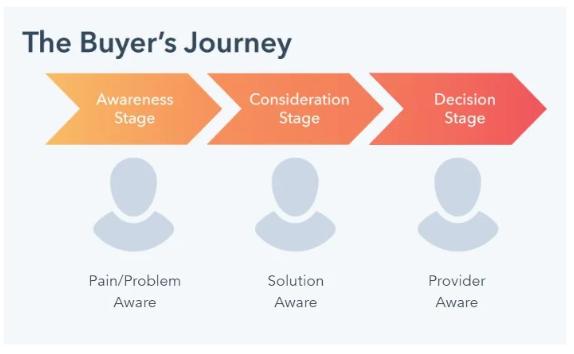

Although Google admits the funnel or buyer journey is very much alive, their extensive research has found that the journey itself is a lot more “messy”, inconsistent and erratic than a clean and sequential model would suggest, as referenced below, and found in the Google research “Decoding Decisions”.
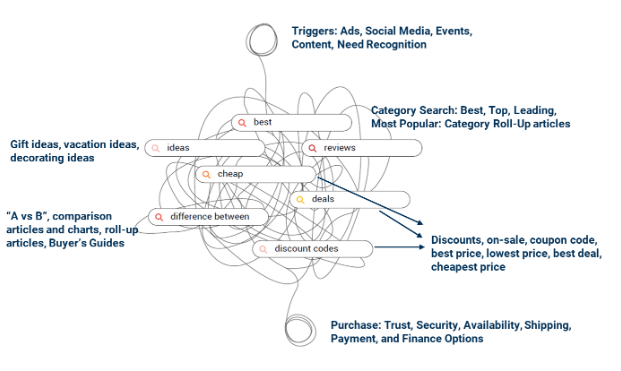
The above illustration from Google indicates that answering all of these search questions and modifiers above is the right, most beneficial, and most consistently searched content type to produce.
As chaotic as this Google buyer journey image may appear, understanding the search intent, the core content strategies and the search modifiers used within the journey is what changes the game for those who understand and execute it.
However, you care to look at the buyer journey (vertical, horizontal, or a squiggly mess), the right content and learning to think like the consumer, and therefore to think like Google always matters.
The right content will answer the shopper's questions and appear toward the top of the organic search results for the common search terms, keywords, and search modifiers they are using at each stage of the funnel and the buyer journey.
What's Below
There are two parts to the remainder of this research that improves SEO (organic site traffic) and CRO (conversion rate optimization).
Part I
A sequential timeline and overview of many (certainly not all) of the Google Algorithm updates since 2011 indicate Google’s desire for high-quality, original, informative, helpful, and objective content that helps consumers answer their questions, solve their problems, and helps make better buying decisions.
The common thread that becomes apparent in these updates is the following:
- High-quality content that is thorough and accurate, well written (spelling and punctuation), and sourced with citations.
- Trustworthy content that is written by someone who knows the subject matter well.
- Fast-loading pages and sites that are well-designed, easy to navigate, easy to index, and easy to read on any device.
Because Google has been basically telling us for years exactly what they are looking for, we certainly can’t blame Google if our search rankings fall, or if we never achieve the results we want. The recipe book is right in front of us, we just need to read it and follow it, and stop trying to game it and take shortcuts that never last.
Part II
An overview of several behavioral science studies that have been proven through scientific rigor to positively impact conversion rate. These are conversion strategies that play on psychology and known human persuasion techniques to enhance or accelerate the content conversion strategy.
In this section, I highlight those conversion principles that show a pattern, or a common thread among 2 or more experts.
Part I: SEO and Googles Updates
What is a Core Update?
A core update means that Google has made significant and broad changes to the algorithm. Core updates tend to have larger impacts on rankings. Sites that are aligned to the core updates perform better in search, and those sites that are not aligned to the new search criteria perform worse.
Core updates occur less frequently than the common and frequent updates that happen several times per year, with little noticeable search impact.
Many SEOs believe that the smaller updates are tests of parts of the algorithm before Google makes the larger core update.
To learn more about core updates:
- https://developers.google.com/search/blog/2019/08/core-updates#:~:text=Several%20times%20a%20year%2C%20we,may%20also%20affect%20Google%20Discover.
- https://www.searchmetrics.com/glossary/google-updates/
- https://www.searchenginejournal.com/google-algorithm-updates-for-user-experience-timeline/395070/
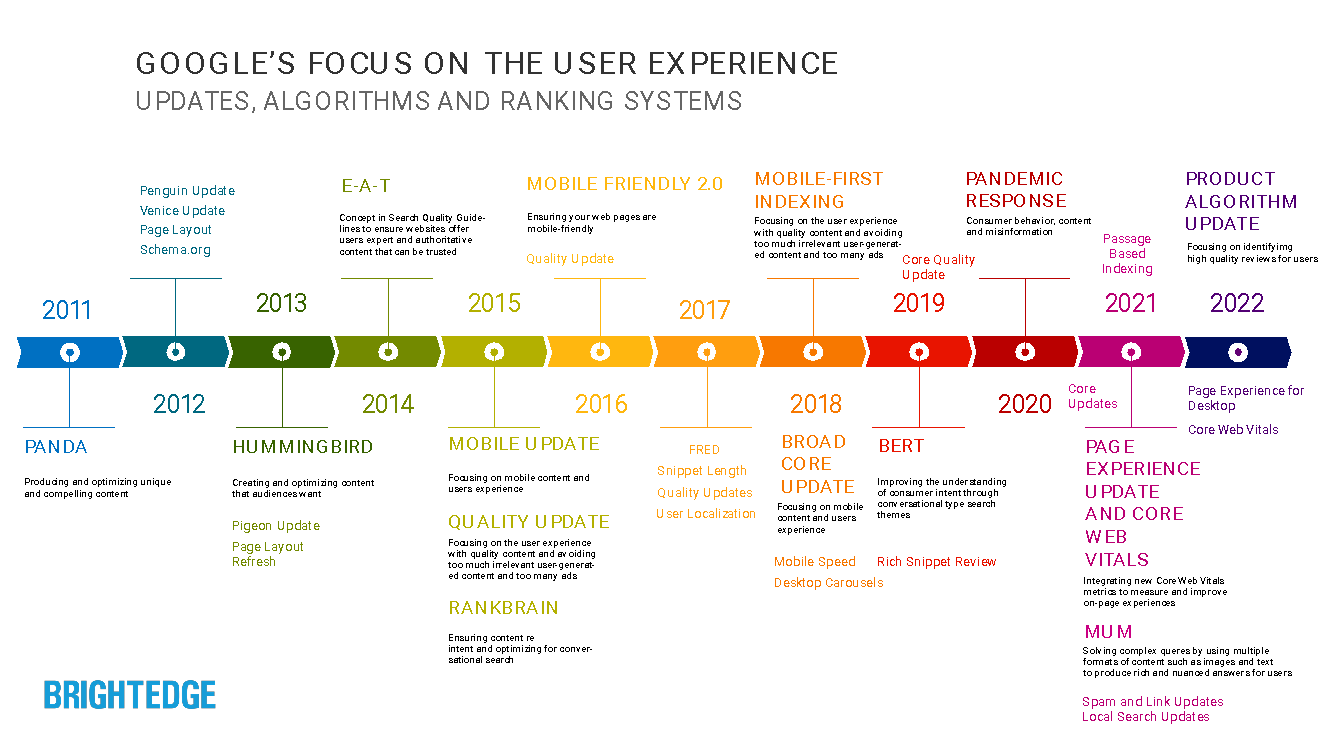
Timeline of Google's Updates and Algorithms
Panda (2011) - High-Quality Content and User Experience. Core Update
Google Panda first launched in February 2011 as part of Google’s quest to eliminate black hat SEO tactics and webspam (poor quality content and poor quality backlinks)
The Panda update assigned pages a quality classification modeled after human quality ratings, which was incorporated as a ranking factor.
Fast forward to 2021, and you can now see how important it was as Google’s first step to focus on quality and user experience.
“This update is designed to reduce rankings for low-quality sites – sites which are low-value add for users, content from other websites or sites that are just not very useful. At the same time, it will provide better rankings for high-quality sites – sites with original content and information such as research, in-depth reports, thoughtful analysis, and so on.”
Singhal (Google) later released the following 23 questions as guiding questions on the Panda algorithm was based on:
- Would you trust the information presented in this article?
- Is this article written by an expert or enthusiast who knows the topic well, or is it more shallow in nature?
- Does the site have duplicate, overlapping, or redundant articles on the same or similar topics with slightly different keyword variations?
- Would you be comfortable giving your credit card information to this site?
- Does this article have spelling, stylistic, or factual errors?
- Are the topics driven by the genuine interests of readers of the site, or does the site generate content by attempting to guess what might rank well in search engines?
- Does the article provide original content or information, original reporting, original research, or original analysis?
- Does the page provide substantial value when compared to other pages in search results?
- How much is quality control done on content?
- Does the article describe both sides of a story?
- Is the site a recognized authority on its topic?
- Is the content mass-produced by or outsourced to a large number of creators, or spread across a large network of sites, so that individual pages or sites don’t get as much attention or care?
- Was the article edited well, or does it appear sloppy or hastily produced?
- For a health-related query, would you trust information from this site?
- Would you recognize this site as an authoritative source when mentioned by name?
- Does this article provide a complete or comprehensive description of the topic?
- Does this article contain insightful analysis or interesting information that is beyond obvious?
- Is this the sort of page you’d want to bookmark, share with a friend, or recommend?
- Does this article have an excessive amount of ads that distract from or interfere with the main content?
- Would you expect to see this article in a printed magazine, encyclopedia, or book?
- Are the articles short, unsubstantial, or otherwise lacking in helpful specifics?
- Are the pages produced with great care and attention to detail vs. less attention to detail?
- Would users complain when they see pages from this site?
In my opinion, these criteria became the basis for what later became the Google E-A-T criteria and update (Expertise, Authority, and Trustworthiness).
Penguin (2012) - Quality Backlinks Matter, Garbage Links are Dead. Core Update
Google’s war on low quality started with the Panda algorithm, and Penguin was an extension and addition to the arsenal to fight this war.
Penguin worked toward ensuring that natural, authoritative, and relevant links rewarded the websites they pointed to, while manipulative and spammy links were downgraded.
Hummingbird (September 2013) - Keyword Exact Match is Reduced, and Topic Match Improves. Core Update
Hummingbird enabled Google to be more precise about what a query meant. After Hummingbird, Google was no longer exact matching keywords in search queries to keywords in webpages.
And, by moving away from matching keywords in a query to keywords on a webpage, Google became more precise about showing pages that matched the topic inherent in the search query.
There are three key takeaways from Matt’s explanation of what Hummingbird does:
- Google no longer relies on just matching keywords in the search query.
- Google identifies which words in a query are important and which are not.
- Hummingbird is a step in the direction of understanding queries more precisely.
Rankbrain (2015) - Optimize Content for User Intent
RankBrain is a system by which Google can better understand the likely user intent of a search query. This further reduced the significance of “keywords” and keyword stuffing and manipulation in content
At its core, RankBrain is a machine learning system that builds off Hummingbird, which took Google from a “strings” (string of words) to “things” (what are they looking for) environment.
Quality Update (May 2015) - Trustworthy Content
The first Quality Update was launched to demote the rankings of low-quality content in organic search so users could get better, more trustworthy, and authoritative results.
What the Quality Update penalized and de-ranked:
1. Thin Content & Clickbait Articles
Thin content is just like it sounds. It’s skimpy. The information is slim. It doesn’t really provide any answers. Plus, it’s short (and not sweet).
2. Pages with Heavy Advertising
In-your-face ads are annoying – nobody will disagree about that. When you’re trying to find information that’s important to you, getting slammed with a page full of ads is also confusing. It gets in the way of your ability to get the information you need.
3. Content Farm Articles & Mass-Produced ‘How-To’ Pages
A great example of sites the Google update impacted negatively are content farms. They’re definitely not as prevalent in organic search results today, and Google’s updates most likely have plenty to do with that
Fred (March 2017)
Fred was preceded a month earlier by a major Google Core Update, which was said to focus on E-A-T.
A week after Fred, Google announced Project Owl, which was designed to clear away misleading and offensive information based on feedback from their quality raters.
Clearly, Google was highly focused on quality and using data from their quality raters.
Fred was no exception.
Google’s Fred algorithm update was rolled out in an attempt to remove what Google perceived as low-quality results — sites that relied on thin content and aggressive ad placement. Many were affiliate sites, though not all.
However, the quality of the content on the affected sites tended to be very low, with highly prevalent ads. You know the sites. You probably avoid them.
Fred did have to do with E-A-T, and the impacted sites imply that the areas it targeted were some or all of:
- Too many ads.
- Thin content.
- Poor link quality.
- Poor content quality.
- Aggressive affiliate linking.
- Overwhelming interstitials.
- Deceptive ads (ads that appear as content).
- Disproportionate Main Content/Supplemental Content ratio.
If you want a refresher on E-A-T and the Quality Raters’ Guidelines, you’ll find one here.
Medic (2018) - Supports E-A-T
The Medic update improved the identification of Expertise, Authority, and Trustworthiness (EAT) in online content.
There are a number of factors that influence EAT. At the time of this update, if your website had minimal reviews and backlinks, was thin on content, wasn’t updated frequently, or lacked comprehensive profiles of the business and authors of the content, your pages might have been pushed down in search results in favor of links that completed more of this checklist.
BERT (2019)
The BERT algorithm (Bidirectional Encoder Representations from Transformers) is a natural language processing machine learning system. It helps a search engine to understand what words in a sentence mean to a human being. The BERT update enables Google to understand search queries more effectively and determine which content is of higher quality, and more relevant to user search queries. After BERT, Google can determine nuance and subtle distinctions of meaning for words based on context.
How does it work? Well, for example, if you say "he's the GOAT" you don't mean he's a farm animal. You mean he's "the greatest of all time." With Google's natural language processing ability, Google would be able to make that distinction.
BERT changes the way SEO copywriters write about topics. Specific keywords become less important and the natural language associated with specific keywords becomes more important. If you are writing quality content on a given topic, giving the correct information, and are in conversation with others who have already written on the topic (citing sources), then the Google algorithm should be able to pick up on that.
Product Reviews (July 2022) - High-Quality Product Reviews for eCommerce Sites
Publishing high-quality product reviews on your eCommerce or product review site can help shoppers learn more about a product before purchasing. For example, reviews can guide shoppers between competing products, helping shoppers pick the best make or model for their needs and budget.
To help shoppers discover your product reviews in Google Search and on other Google surfaces, follow these best practices:
- Evaluate the product from a user's perspective.
- Demonstrate that you are knowledgeable about the products reviewed – show you are an expert.
- Provide evidence such as visuals, audio, or other links of your own experience with the product, to support your expertise and reinforce the authenticity of your review.
- Share quantitative measurements about how a product measures up in various categories of performance.
- Explain what sets a product apart from its competitors.
- Cover comparable products to consider, or explain which products might be best for certain uses or circumstances.
- Discuss the benefits and drawbacks of a particular product, based on your own original research.
- Describe how a product has evolved from previous models or releases to provide improvements, address issues, or otherwise help users in making a purchase decision.
- Identify key decision-making factors for the product's category and how the product performs in those areas (for example, a car review might determine that fuel economy, safety, and handling are key decision-making factors and rate performance in those areas).
- Describe key choices in how a product has been designed and their effect on the users beyond what the manufacturer says.
- Include links to other useful resources (your own or from other sites) to help a reader make a decision.
- Consider including links to multiple sellers to give the reader the option to purchase from their merchant of choice.
- When recommending a product as the best overall or the best for a certain purpose, include why you consider that product the best, with first-hand supporting evidence.
- Ensure there is enough useful content in your ranked lists for them to stand on their own, even if you choose to write separate in-depth single product reviews for each recommended product.
https://developers.google.com/search/docs/specialty/ecommerce/write-high-quality-product-reviews
Helpful Content (August 2022) - Connect People to Helpful Information
Just in case we didn’t get the hint from Panda, the E-A-T Guidelines, and the Fred update, the Helpful Content update is very similar to the Panda update, with the same focus on high-quality content that helps consumers solve problems and answer their questions. When combined with the recent Product Reviews update, the collective goals between the two are extremely similar in language and intent to Panda.
I think we can only assume that Google is dead serious about what they are looking for in regard to quality content and backlinks. And with each update, the algorithm gets smarter, and more finely tuned at suppressing the sub-par content, and serving only the best of the best.
Google Search is always working to better connect people to helpful information. To this end, we're launching what we're calling the “helpful content update” that's part of a broader effort to ensure people see more original, helpful content written by people, for people, in search results. Below is more about the update and things creators should consider.
Focus on people-first content
The helpful content update aims to better reward content where visitors feel they've had a satisfying experience, while content that doesn't meet a visitor's expectations won't perform as well.
How can you ensure you're creating content that will be successful with our new update? By following our long-standing advice and guidelines to create content for people, not for search engines. People-first content creators focus first on creating satisfying content, while also utilizing SEO best practices to bring searchers additional value. Answering yes to the questions below means you're probably on the right track with a people-first approach:
- Do you have an existing or intended audience for your business or site that would find the content useful if it came directly to you?
- Does your content clearly demonstrate first-hand expertise and a depth of knowledge (for example, expertise that comes from having actually used a product or service, or visiting a place)?
- Does your site have a primary purpose or focus?
- After reading your content, will someone leave feeling they've learned enough about a topic to help achieve their goal?
- Will someone reading your content leave feeling like they've had a satisfying experience?
- Are you keeping in mind our guidance for core updates and for product reviews?
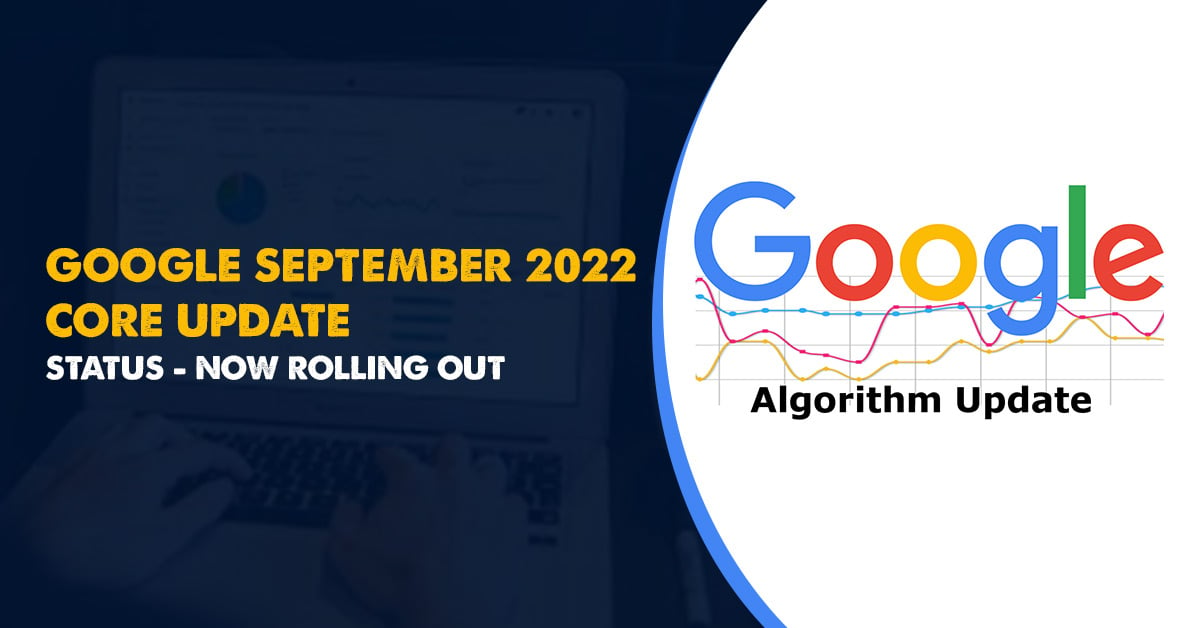
September Core Update (September 2022)
The September Core Update really gave the Helpful Content update teeth and specificity. There are fourteen content quality considerations in the update
- Do real people write your content for real people?
- Have you spent time and effort adding unique information to your content consistently?
- Are you just touching the surface level of the topic or going in-depth?
- What is it that you have in your content that makes it better when compared to the competitors?
- Have you over-optimized the title, description, and content to attract bots and not real users?
- Are you using a clickbait strategy to get the attention of the users?
- Does your content have the potential to get natural references (backlinks)?
- Is the content written by someone who has extensive expertise in the field?
- Do you focus on a niche or write about anything under the sun?
- Is your content going against the generally scientifically proven facts? (EAT)
- Will people lose money or life after trying the recommendations within your content? (EAT)
- Does the content follow grammatical best practices?
- Is it syndicated content?
- Does the content accompany intrusive interstitial elements that cause hindrance to the user experience?
- How good is the mobile experience of your content?
September Product Review Update (9/20/22)
Google’s product review algorithm update aligns to the September Core Update and the Helpful Content Update in terms of helpful, quality, trusted content, but in this case, it is focused on Product Reviews by experts, or publishers (not consumer-generated product reviews).
The Product review Update is designed to reward high-quality product review pages that share in-depth, original, objective research.
Google wants to surface product reviews written by people that have personally tested and experimented with the product they’re reviewing.
You can make this clear to Google, and your readers, by including details such as photos and videos, benefits and drawbacks, comparisons with competing products, and other first-hand observations.
This update applies to websites that publish long-form product reviews, such as those seen on websites like Wirecutter and Tom’s Guide.
When you compare this to the July 2022 Product Review Update, you see the same pattern of objective.
Algorithm Update Summary
It’s my opinion that when you review all the updates listed in this document, the pattern is very clear, and I don’t think Google will ever back down from these quality-seeking criteria
- Objective
- Trustworthy and honest
- Well written, cited, sourced, and structured
- Written from an experts insights and experience, with original research, content, images, and perspectives
- Written by humans, for humans, to solve real peoples problems and answer their questions
Part II: CRO (Conversion Rate Optimization) and Behavioral Science
Leveraging Behavioral Science To Improve Conversion
Certain cognitive biases identified by behavioral science research have some common themes that are interwoven between the various studies and findings, which further validate their efficacy. For example, some common conversion and motivational themes shared among the studies include:
- Social proof (show this is a popular choice, and others have done it, and like it)
- Trust (trusted site, trusted product, trusted content, trusted transaction)
- Authority and expertise
- Simplicity and ease of understanding the value proposition, content, and the ease of taking action
These elements absolutely must be designed into the UX. 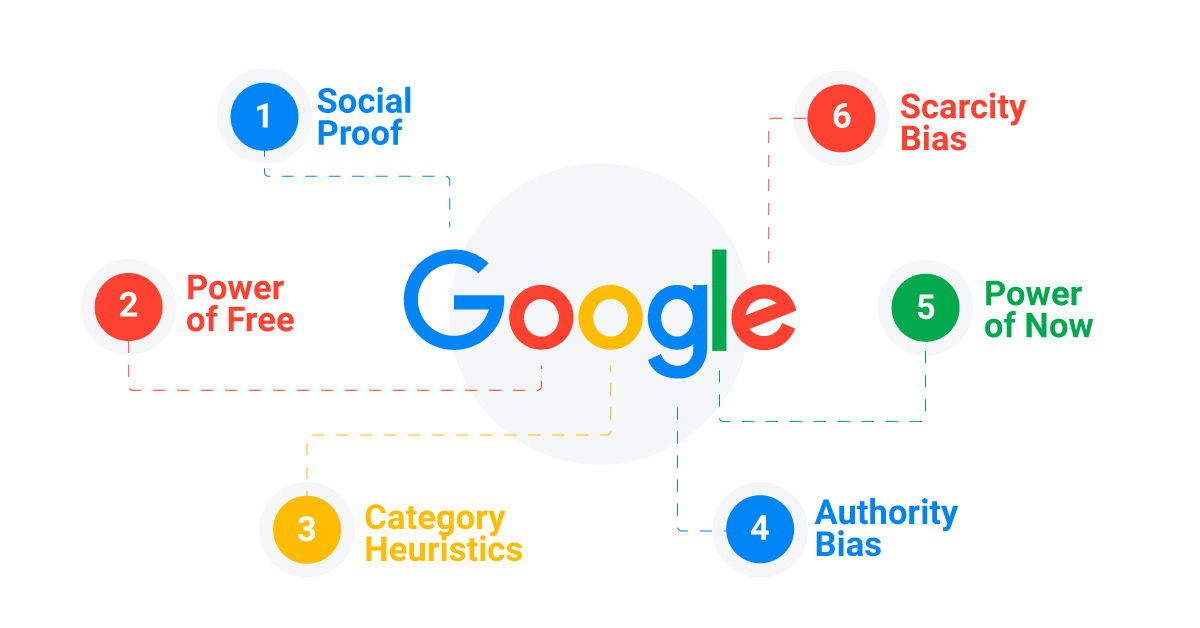
Google’s Cognitive Biases That Drive Conversion
Google has identified six Cognitive Biases for product page content, in rank order of impact on the positive influence of purchase behavior:
- Social proof: Recommendations and reviews from others.
- Power of free: Free shipping, gift, upgrade, or add-on with a purchase, even if unrelated, can be a powerful motivator.
- Category heuristics: Short descriptions of key product specifications can simplify purchase decisions. As long as the specs are important to the audience.
- Authority bias: An expert or trusted source.
- Power of now: The longer you have to wait for a product or solution the weaker the proposition becomes.
- Scarcity bias: As availability decreases, the more desirable it becomes.
The Seven Conversion Principles of Dr. Cialdini – Author of “Influence - The Psychology of Persuasion”
Dr. Cialdini has tested seven proven psychological principles that increase the likelihood of purchase:
- Reciprocity: Give something before you ask for something
- Commitment and Consistency: Use small steps to entice your visitor toward the desired action
- Social Proof: Show that others have done it
- Liking: “People buy from those they know, like, and trust.” Give your visitors a reason to like you
- Authority: We trust people who have more knowledge or expertise than we do
- Scarcity: We attach more value to things that are scarce, or only available for a limited time or quantity (FOMO)
- Unity: We are more likely to trust people who are part of the same group, or similar to ourselves – create a sense of togetherness or community
6,700 Online Experiments
A 2017 meta-analysis (a compilation of multiple studies to identify common effects) of over 6,700 large eCommerce experiments, mainly from the retail and travel sectors, found some very consistent lift factors in the Revenue Per Customer (RPV). These results also support many of the common themes already discussed by the studies in the body of knowledge above.
The top-six most effective features in relation to their average RPV uplift:
- Scarcity—highlighting items low in stock +2.9%
- Social Proof—informing users of others’ behavior +2.3%
- Urgency—using time limits, often with a countdown timer +1.5%
- Abandonment recovery—messaging to keep users on the site +1.1%
- Product recommendations—suggesting other products to purchase +0.4%
The study also found little, no, or even a negative effect on changing website colors, buttons, or calls to action. This study by Browne and Jones, also found that many of the A/B testing practices at the time were fundamentally flawed. I would argue that they still are. Because oftentimes these “experts” are advocating the testing of the same elements that have proven not to be effective at moving the needle.
Dr. BJ Fogg’s Behavior Design – Stanford University Behavioral Scientist
Desired behavior is the result of creating Motivation to act, making the Ability or action simple, and providing a Prompt to act. His research accomplishes this in the following ways:
- Arouse Curiosity: A checklist of things to consider or do works well
- Reduce the Expected Effort: By indicating that the checklist only takes a minute to complete
- Create Anticipatory Enthusiasm: By giving a preview of the result or benefit
- Reduce Mental Effort (Cognitive Load): Reduce and simplify design elements and copy
- Give Reasons Why: Explicitly provide a reason for the desired behavior–save time or money
- Ask For Minor Commitments: “Review prices” is good vs “Buy Now” which is not as effective
- Provide Social Proof: Show that others have done it, and how they liked it
CRO Summary
As you can see, the conversion biases research by Google aligns with the research by Dr. Cialdini and Dr. Fogg along the lines of Social Proof, making ratings and reviews “THE” most researched, tested, and relevant single conversion tool across the leading studies.
To learn how Shopper Approved can help your company leverage social proof and high-quality, authoritative content to drive more traffic and conversions, schedule a demo today.
About Shopper Approved
Shopper Approved helps eCommerce websites increase their traffic and conversions by providing tools that collect, syndicate, and display more UGC, in both paid and organic search results, in the way of Seller, Product, and Video Ratings and Reviews, Q&A, and website security.
Based in the USA since 2010, Shopper Approved has been a Certified Google Review Partner since 2013 for both Seller and Product Reviews.
All of our tools help improve both paid and organic traffic, and conversion rates. The Q&A tool, for example, is designed to show the answer to the product search question in the Featured Snippet.
Shopper Approved has collected over 57 million reviews for over 26,000 eCommerce websites, and has been recognized by Inc. as one of the 500 fastest-growing companies for 2-years in a row, while also being recognized by G2, Capterra and others as the highest-rated review platform on the web.
Additional SEO articles

 Drive More Visibility, Traffic, and Sales
Drive More Visibility, Traffic, and Sales
